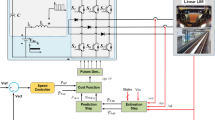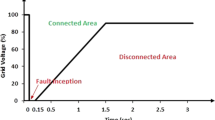Abstract
Selection of better optimized unified power flow controller (UPFC) control inputs along with simultaneous coordinated design of power system stabilizer (PSS) is a challenge in the present scenario of power systems. Hence, in this paper, four sets of experiments performed are presented. First set of experiments are without disturbance scenario where switching is done using linear quadratic regulators (LQR’s). Second set is for power systems with disturbances using linear quadratic gaussian (LQG). Switching control algorithms presented here are tested on the single machine infinite bus (SMIB) linearised Phillips Heffron model of power system using MATLAB/SIMULINK® platform.
Similar content being viewed by others
References
A. M. Yousef, A M. Kassem. Optimal power system stabilizer based enhancement of synchronizing and damping torque coefficients. WSEAS Transactions on Power Systems, 2012, 7(2): 70–79.
H. N. Al-Duwaisha, Z. M. Al-Hamouz. A neural network based adaptive sliding mode controller: application to a power system stabilizer. Energy Conversion and Management, 2011, 52(2): 1533–1538
G. X. Athanasius, Hemanshu R. Pota, V. Ugrinovskii. Robust decentralized switching power system stabilisers for interconnected power grids: stability us. IFAC Proceedings Volumes, 2008, 41(2): 8419–8424.
V. Bandal, B. Bandyopadhyay, A. M. Kulkarni. Output feedback fuzzy sliding mode control technique based power system stabilizer (PSS) for single machine infinite bus (SMIB) system. IEEE International Conference on Industrial Technology, Hong Kong: IEEE, 2005: 341–346
K. Davooodi, S. Patilkulkarni. Hybrid Modeling and Control of Power Systems with PSS Operating over Wide Range of Operating Conditions. IEEE International Conference on Power Systems, New Delhi: IEEE, 2016: DOI 10.1109/ICPES.2016.7584243.
H. F. Wang. A unified model for the analysis of FACTS devices in damping power system oscillations–Part III: Unified power flow controller. IEEE Transactions on Power Delivery, 2000, 15(3): 978–983.
H. Shayeghi, H. A. Shayanfar, S. Jalilzadeh, et al. Design of output feedback UPFC controller for damping of electromechanical oscillations using PSO. Energy Conversion and Management, 2009, 50(10): 2554–2561.
N. Tambey, M. L. Kotharir. Unified power flow controller (UPFC) based damping controllers for damping low frequency oscillations in a power system. Maturitas, 2003, 72(1): 35–41.
A. K. Baliarsingh, S. Panda, A. K. Mohanty, et al. UPFC supplementary controller design using real-coded genetic algorithm for damping low frequency oscillations in power systems. International Journal of Electrical and Computer Engineering, 2013, 7(4): 759–761.
K. M. Son, J. K. Park. On the robust LQG control of TCSC for damping power system oscillations. IEEE Transactions on Power Systems, 2000, 15(4): 1306–1312
A. Elahi, A. Gholizadeh, A. Aghae. Linear quadratic Gaussian control for UPFC auxiliary stabilizer. Science International, 2014, 26(5): 2353–2356.
P. Pourbeik, M. J. Gibbard. Simultaneous coordination of powersystem stabilizers and FACTS device stabilizers in a multimachine power system for enhancing dynamic performance. IEEE Transaction on Power Systems, 1998, 13(2): 473–479.
L. J. Cai, I. Erlich. Simultaneous coordinated tuning of PSS and FACTS damping controllers in large power systems. IEEE Transaction on Power Systems, 2005, 20(1): 294–300.
L. Yathisha, S. S. P. Kulkarni. Optimal switched feedback controller design for the simultaneous coordinated design of UPFC and PSS in power system. Journal of Electrical Engineering, 2016, 16(4): 414–421
A. M. Yousef, M. K. Ei-Sherbiny. Improvement Of synchronizing and damping torque coefficients based LQR power system stabilizer. International Conference on Electrical, Electronic and Computer Engineering, Cairo, Egypt: IEEE, 2004: 753–758
A. Alfi, M. Khosravi. Optimal power system stabilizer design to reduce low frequency oscillations via an improved system optimization algorithm. International Journal on Technical and Physical Problems of Engineering, 2012, 4(2): 24–33.
Al. Olimat, K. S. Farhoud, J. K. Hurtig. Power system stabilizers with fuzzy logic switching. Power Systems Conference and Exposition, Atlanta: IEEE, 2006: 2152–2157
B. D. O. Anderson, J. B. Moore. Optimal Control: Linear Quadratic Methods. New York: Dover Publications, 2007.
L. Yathisha, S. P. Kulkarni. Optimum LQR switching approach for the improvement of STATCOM performance. Proceedings of the Third International Conference on Trends in Information, Telecommunication and Computing, New York: Springer, 2013: 259–266
S. Skogestad, I. Postlethwaite. Multivariable Feedback Control Analysis and Design. 2nd ed. New York: John Wiley & Sons, 2001.
H. Ye, Y. Liu. Design of model predictive controllers for adaptive damping of inter-area oscillations. Electrical Power and Energy Systems, 2013, 45(1): 509–518.
X. Yang, O.n Marjanovic. LQG control with extended Kalman filter for power systems with unknown time-delays. IFAC Proceedings Volumes, 2011, 44(1): 3708–3713.
S. P. Azad, R. Iravani, T. J. E. Damping inter-area oscillations based on a model predictive control (MPC) HVDC supplementary controller. IEEE Transactions on Power Systems, 2013, 28(3): 3174–3183
P. Tripathy, S. C. Srivastava, S. N. Singh. A divide-by-differencefilter based algorithm for estimation of generator rotor angle utilizing synchrophasor measurements. IEEE Transactions on Instrumentation and Measurement, 2010, 59(6): 1562–1570
A. M. Yousef, M. Zahran. Improved power system stabilizer by applying LQG controller. Advances in Electrical and Computer Engineering, 2008, 8(1): 117–127.
K. R. Santarelli, M. A. Dahleh. Comparison between a switching controller and two LTI controllers for a class of LTI plants. International Journal on Robust Nonlinear Control, 2008, 19(2): 1–33
K. R. Santarelli, M. A. Dahleh. L 2 gain stability of switched output feedback controllers for a class of LTI systems. IEEE Transactions on Automatic Control, 2009, 54(7): 1504–1514
K. R. Santarelli, M. A. Dahleh. Optimal controller synthesis for a class of LTI systems via switched feedback. Systems & Control Letters, 2010, 59(3): 258–264
Z. D. SUN. Recent advances on analysis and design of switched linear systems. Control Theory and Technology, 2017, 15(3): 242–244.
Z. H. Huang, C. Xiang, H. Lin, et al. A necessary and sufficient condition for stability of arbitrarily switched second-order LTI System: Marginally stable case. Proceedings of the 22nd IEEE International Symposium on Intelligent Control, Part of IEEE Multiconference on Systems and Control, Singapore: IEEE, 2007: 83–88
L. S. Devarakonda. Performance Based Switching Control for Single Input LTI Systems. M.Sc. thesis. Baton Rouge: Louisiana State University and Agricultural and Mechanical College, 2005.
J. L. Aravena, L. Devarakonda. Performance driven switching control. IEEE International Symposium on Industrial Electronics, 2006: DOI 10.1109/ISIE.2006.295564.
L. Yathisha, K. Davoodi, S. P. Kulkarni. Optimal switching control strategy for UPFC for wide range of operating conditions in power system. Proceedings of 3rd Indian Control Conference, Guwahati: IEEE, 2007: 225–232
L. Yathisha, S. P. Kulkarni. Application and comparison of switching control algorithms for power system stabilizer. IEEE International Conference on Industrial Instrumentation and Control, Pune: IEEE, 2015: 1300–1305
Acknowledgements
The authors appreciate Dr. P. K. Mahesh, Head of Electronics and Communication Department, Dr. L. Basavaraj, Principal, both from ATME College of Engineering, Mysore, and Dr. M. N. Shanmukhaswamy, Head of Electronics and Communication Department, Dr. Syed Shakeeb ur Rehman, Principal, both from Sri Jayachamarajendra College of Engineering, Mysore, for their moral support and encouragement during this research work.
Author information
Authors and Affiliations
Corresponding author
Additional information
This work was supported by Sri Jayachamarajendra College of Engineering (JSSSTU), Mysuru, Karnataka, India.
L. YATHISHA received his M.Tech. degree in Industrial Electronics and Ph.D. degee in Control Systems from SJCE, Visvesvaraya Technological University (VTU), in 2017 and 2010, respectively. Since 2012 He has been working as Assistant Professor in the Department of Electronics and Communication Engineering, ATME College of Engineering (affiliated to VTU), Mysore, India. His areas of interests are power systems, control systems and hybrid control systems. E-mail: yathisha.171@gmail.com.
S. PATILKULKARNI received his Ph.D. degree from Old Dominion university, Norfolk, Virginia, U.S.A., in 2004. He is currently working as Professor in the Department of Electronics and Communication at Sri Jayachamarajendra College of Engineering (SJCE), JSS Science and Technology University, Mysore, India. His research interests include control systems, hybrid and stochastic systems, VLSI, signal and image processing. E-mail: sudarshan_ pk@sjce.ac.in.
Rights and permissions
About this article
Cite this article
Yathisha, L., Patilkulkarni, S. LQR and LQG based optimal switching techniques for PSS and UPFC in power systems. Control Theory Technol. 16, 25–37 (2018). https://doi.org/10.1007/s11768-018-6174-x
Received:
Revised:
Accepted:
Published:
Issue Date:
DOI: https://doi.org/10.1007/s11768-018-6174-x




